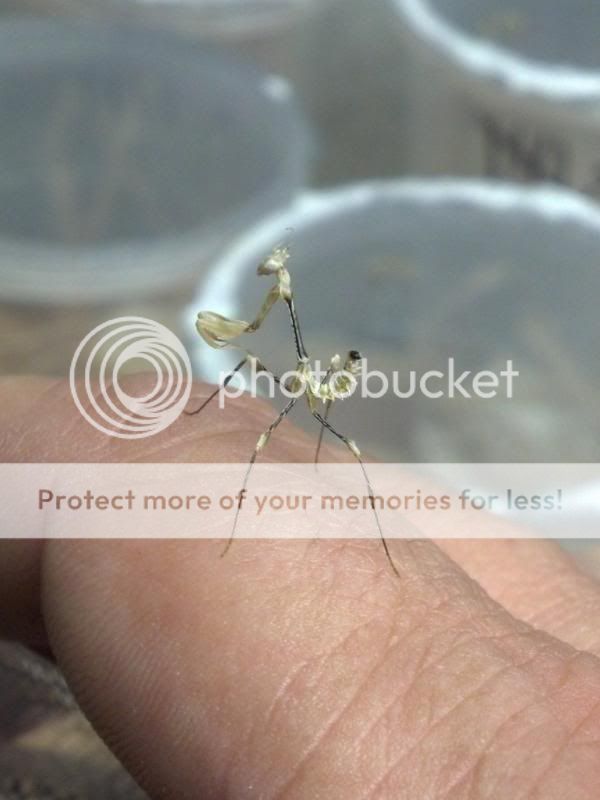brancsikia339
Well-known member
Gongylus gongylodes (Violin Mantis)
Introduction:Gongylus gongylodes is a mantis in the Empusidae family. They are native to India, Java, Myanmar, Sri Lanka and Thailand. Adults reach about 4-4½ in total length, males being on the smaller side.(brancsikia339)
Their much rarer relative, Gongylus trachelophyllus, occurs only in India, and it seems that these don't exist in culture as of now.(brancsikia339)
They go by many common names so it is best not to trust these (Other than violin mantis, its most common name): violin mantis, wandering violin mantis, wandering rose mantis, dead leaf mantis, stick mantis, Indian rose mantis, rose mantis, Indian violin mantis, and ornate mantis. This species has an array of common names.(brancsikia339)
All in all, Gongylus gongylodes is an incredible species, though not for the novice.(brancsikia339)
- Physical description/appearance, i.e. size, color, shape, crypsis, etc.
- Rate of growth and factors involved
- Longevity
- Molting observations
- Degree of activity
- Degree of aggression or timidity
- Propensity to cannibalize
- Dynamics of threat display
They need a lot of twigs and branches to molt on. They also need high temps, up to the mid 90's and down to the low 80's to molt properly.(brancsikia339)
I've kept this species many times, and I found that the hotter the better within reason. They did best in net cages with a heat lamp above the enclosure. I misted daily.(Rick)
I never had any trouble keeping them communally but it may be best to keep males and female adults separate except for breeding purposes.(Rick)
As all Empusids, this species cannot climb smooth surfaces and should get mesh or twigs to hang from. Temperatures should be about 80 for nymphs, and about 95 for adult males before breeding. Humidity needs only to be at 40-50%.(agent A)
- Type and size of enclosure(s) used.
- Substrate or lack thereof
- Cage furnishings, e.g. molting surfaces, perches, décor, plants, etc.
They feed exclusively on flying food, but have been known to eat crickets. This can have adverse side effects, however.(brancsikia339)
L1's through L3's for me were fed on mostly melanogasters and hydeis. From L4 on, they were fed mostly houseflies until some higher molts, in which they will accept BB's. They will also accept treats such as moths, butterflies, wasps and bees. (Bees not recommended because of rarity, and wasps can be dangerous to the mantids).(brancsikia339)
These mantids prefer flying food and I raised them on flies. Start out with hydei fruit flies and transition them to houseflies followed by bluebottle flies. They do enjoy other flying insects such as moths.(Rick)
Breeding:
Males are volitable(able to fly) and females have short wings.(brancsikia339)
This species is tricky to breed because males need high temps to mate, but an easy way to eggbind a female is overexposure to high temperatures. Keep the male in a hot, humid cage for a few days in a separate room (95F, 60-70%), then one evening introduce the female. Connection can still occur at room temp but the male needs high temps beforehand to make it work.(agent A)
I incubate the ooths at 93f during the day and drop to 86f at night. I mist the container every other day one light mist. My temps are from a incubator so they don't fluctuate and have near perfect hatches in 4 to 6 weeks.(jrh3)
- Sexing/sexual dimorphism (explanation of physical differences and/or adult sizes of the sexes)
- Time needed from last molt to copulation
- Tips: give us your methodology.
- Tips for inducing copulation and fecundity
- Tips for inducing female to lay oothecae
Ooths of gongylus are very peculiar, being spiky all around with a large protrustion on the front.(brancsikia339)
- Physical description and average size. Picture desired; include with other pictures at bottom of Care Sheet.
- Diapause if necessary
- Incubation time and temperature
- Observed number/s and range of hatching nymphs
- Health Issues: infections or illnesses encountered.
- Additional Observations: pertinent information which doesn't neatly fit anywhere else.
- Photos: up to five may be posted at the bottom of the completed template. Please limit these photos to no more than one of an ootheca, two of nymphs(different instars), one of an adult female, and one of an adult male.

(photo: jrh3)

(photo: jrh3)
Contributors: agent A, brancsikia339, jamurfjr, jrh3, Rick
Last edited by a moderator:



